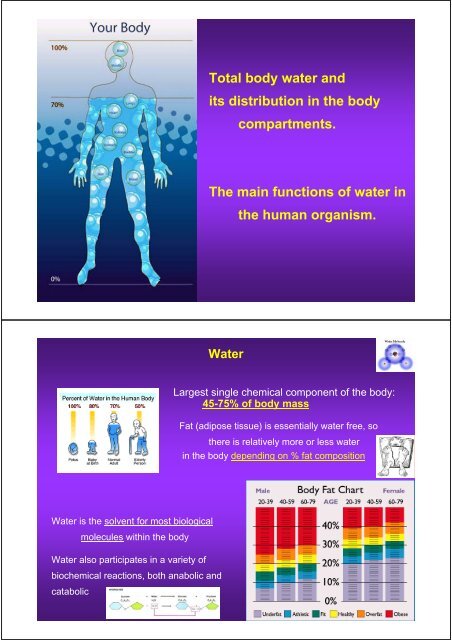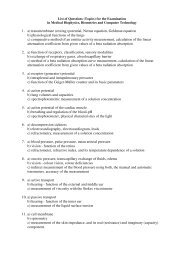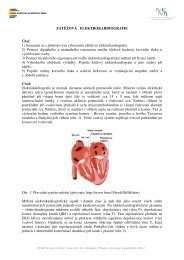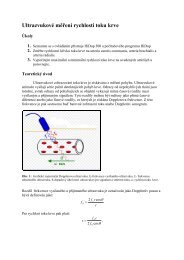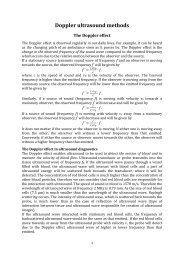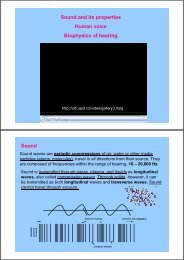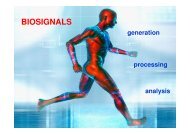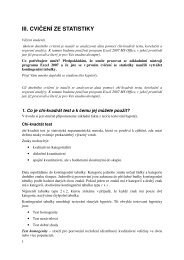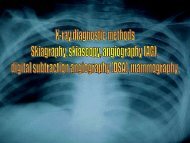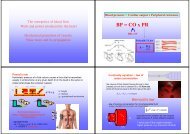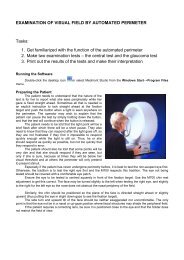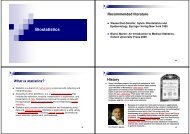Total body water and its distribution in the body compartments. The ...
Total body water and its distribution in the body compartments. The ...
Total body water and its distribution in the body compartments. The ...
- No tags were found...
Create successful ePaper yourself
Turn your PDF publications into a flip-book with our unique Google optimized e-Paper software.
<strong>Total</strong> <strong>body</strong> <strong>water</strong> <strong>and</strong><strong>its</strong> <strong>distribution</strong> <strong>in</strong> <strong>the</strong> <strong>body</strong><strong>compartments</strong>.<strong>The</strong> ma<strong>in</strong> functions of <strong>water</strong> <strong>in</strong><strong>the</strong> human organism.WaterLargest s<strong>in</strong>gle chemical component of <strong>the</strong> <strong>body</strong>:45-75% of <strong>body</strong> massFat (adipose tissue) is essentially <strong>water</strong> free, so<strong>the</strong>re is relatively more or less <strong>water</strong><strong>in</strong> <strong>the</strong> <strong>body</strong> depend<strong>in</strong>g on % fat compositionWater is <strong>the</strong> solvent for most biologicalmolecules with<strong>in</strong> <strong>the</strong> <strong>body</strong>Water also participates <strong>in</strong> a variety ofbiochemical reactions, both anabolic <strong>and</strong>catabolic
Fluid Compartments• <strong>Total</strong> Body Water (TBW) - 42L,60% of <strong>body</strong> weight– Intracellular Fluid (ICF) -28L, 67% of TBW– Extracellular Fluid (ECF) -14L, 33% of TBW• Interstitial Fluid - 11L,80% ECF• Plasma - 3L, 20% ofECFWater balance– Sources for 2500 ml- average daily<strong>in</strong>take• Metabolic Water• Preformed Water– Ingested Foods– Ingested Liquids– Balance achieved ifdaily output also =2500 ml• GI tract• Lungs• Sk<strong>in</strong>– evaporation– perspiration• Kidneys
Water Movement Between <strong>the</strong> ICF <strong>and</strong> ECFOsmolality – <strong>the</strong> concentrations of solutes <strong>in</strong> <strong>water</strong>– solutes will <strong>in</strong>fluence <strong>the</strong> movement of <strong>water</strong> across membranesH 2Oπ = iRTcAquapor<strong>in</strong>s- <strong>water</strong> channel prote<strong>in</strong>s <strong>in</strong> membranesNet filtration (Starl<strong>in</strong>g hypo<strong>the</strong>sis)H 2O= forces favor<strong>in</strong>g filtration – forces oppos<strong>in</strong>g filtrationAs fluid flows through capillary it looses <strong>water</strong> <strong>and</strong> create greater osmoticreturn of <strong>water</strong> as it flows toward ve<strong>in</strong>ule end of capillaryForces favor<strong>in</strong>g filtration- Capillary hydrostatic pressure (blood pressure)- Interstitial oncotic pressure (<strong>water</strong>-pull<strong>in</strong>g)Forces favor<strong>in</strong>g reabsorptionfiltrationH 2O- Plasma oncotic pressure (<strong>water</strong>-pull<strong>in</strong>g)reabsorption- Interstitial hydrostatic pressureOncotic pressure…Colloid osmotic pressure• is formed by colloid particles dissolved <strong>in</strong> solution• <strong>in</strong> plasma <strong>the</strong> major part forms prote<strong>in</strong>s 65-85 g/lElectrophoretic separation of plasma prote<strong>in</strong>s(directly proportional to size <strong>and</strong> charge)Album<strong>in</strong>60%α 1globul<strong>in</strong> α1-antitryps<strong>in</strong>, α1-acid glycoprote<strong>in</strong>α 2globul<strong>in</strong> haptoglob<strong>in</strong>, α2-macroglobul<strong>in</strong>,α2-antiplasm<strong>in</strong>, ceruloplasm<strong>in</strong>4% 7%β globul<strong>in</strong>transfer<strong>in</strong>, complement, LDL10%fibr<strong>in</strong>ogenγ globul<strong>in</strong> = Imunoglobul<strong>in</strong>sIgA, IgD, IgE, IgG <strong>and</strong> IgMMr 67x10 3 Mr150x10 3Mr340x10 35% 14%
Water Movement Between <strong>the</strong> ICF <strong>and</strong> ECFOsmotic Equilibrium
Plasma Osmolarity - Measures ECF Osmolarity• Plasma is cl<strong>in</strong>ically accessible• Dom<strong>in</strong>ated by [Na + ] <strong>and</strong> <strong>the</strong> associated anions• Under normal conditions, ECF osmolarity can be roughly estimatedas:P OSM = 2 [Na + ] p……..270-300 mOsm{ P OSM = 2[Na + ] + 2[K + ] + [Urea] + [Glucose] }EdemaAccumulation of fluid with<strong>in</strong> <strong>the</strong><strong>in</strong>terstitial spaces• Causes:– Increase <strong>in</strong> hydrostatic pressure (blood pressure / hypertension)– Losses or dim<strong>in</strong>ished production of plasma album<strong>in</strong> (hypoprote<strong>in</strong>emia…decrease <strong>in</strong> oncotic pressure /malnutrition (at <strong>in</strong>sufficient supply of prote<strong>in</strong>s…abdom<strong>in</strong>al edema/ <strong>in</strong>sufficient production of prote<strong>in</strong>s at cirrhosis/ largelosses of prote<strong>in</strong>s by kidney at nephrotic syndrome/)- Increases <strong>in</strong> capillary permeability (at anaphylaxis, allergicreaction (release of histam<strong>in</strong>), <strong>in</strong>flammation)- Lymph obstruction – elephantitus, flibitus- Decreased resorption due to raised systemic venouspressure – edema due to heart failure
EdemaRegulat<strong>in</strong>g Fluid IntakeThirstThirst Quench<strong>in</strong>g1. 2.Wett<strong>in</strong>g <strong>the</strong> oral mucosa(temporary)Stretch<strong>in</strong>g of <strong>the</strong> stomachDecreased blood/<strong>body</strong>fluid osmolarity =<strong>in</strong>creased hydration(dilution) of <strong>the</strong> blood is<strong>the</strong> most important
Regulation of Fluid Output• Hormonal control– Antidiuretic hormone (ADH) [neurohypophysis]– Aldosterone [adrenal cortex]– Atrial natriuretic peptide (ANP) [heart atrial walls]• Physiologic fluid imbalances– Dehydration: ↓ blood pressure, ↓ GFR– Overhydration: ↑ blood pressure, ↑ GFR– Hyperventilation - <strong>water</strong> loss through lungs– Vomit<strong>in</strong>g & Diarrhea - excessive <strong>water</strong> loss– Fever - heavy perspiration– exudat<strong>in</strong>g Burns, contusion - fluid loss– Hemorrhage – if blood loss is severe
Atrial natriuretic peptide (ANP) is a 28-am<strong>in</strong>o acid peptide that is syn<strong>the</strong>sized, stored, <strong>and</strong>released by atrial myocytes <strong>in</strong> response to atrial distension- elevated levels of ANP are found dur<strong>in</strong>g hypervolemic states (elevated blood volume) <strong>and</strong>congestive heart failureA second natriuretic peptide (bra<strong>in</strong>-type natriuretic peptide; BNP) is a 32-am<strong>in</strong>o acid peptide thatis syn<strong>the</strong>sized with<strong>in</strong> <strong>the</strong> ventricles (as well as <strong>in</strong> <strong>the</strong> bra<strong>in</strong> where it was first identified). LikeANP, BNP is released by <strong>the</strong> same mechanisms that release ANP, <strong>and</strong> it has similarphysiological actions, BNP serves as sensitive, diagnostic markers for heart failure <strong>in</strong>patients
Regulation of Fluid OutputOsm V PBADHFactors affect<strong>in</strong>gADH release
Ur<strong>in</strong>e osmolarity regulation by ADHADHHuman angiotens<strong>in</strong>ogenis 118 am<strong>in</strong>o acids longPathway of RAAS
Pr<strong>in</strong>cipal cells & aldosteroneAtrial natriuretic peptide28-am<strong>in</strong>o acid peptide
Distribution of SolutesInterstitial fluid is essentially anultrafiltrate of plasma, <strong>water</strong> <strong>and</strong>electrolytes move freely with<strong>in</strong>this compartment <strong>and</strong> between it<strong>and</strong> <strong>the</strong> <strong>in</strong>travascular fluid.Intravascular fluid has almost <strong>the</strong>same composition as <strong>in</strong>terstitialfluid except for <strong>its</strong> higher prote<strong>in</strong>level.Electrolyte BalanceElectrolytes have 4 important physiological functions <strong>in</strong> <strong>the</strong> <strong>body</strong>• essential m<strong>in</strong>erals <strong>in</strong> certa<strong>in</strong> biochemical reactions• control osmosis = control <strong>the</strong> movement of <strong>water</strong> between<strong>compartments</strong>• ma<strong>in</strong>ta<strong>in</strong> acid-base balance• conduct electrical currents (depolarization events)Regulators:Aldosterone ↑ [Na + ] [Cl - ] [H 2 O] ↓ [K + ]Atrial Natriuretic Peptide (opposite effect)Antidiuretic Hormone ↑ [H 2 O] (↓ [solutes])Parathyroid Hormone ↑ [Ca ++ ] ↓ [HPO 4- ]Calciton<strong>in</strong> (opposite effect)Female sex hormones ↑ [H 2 O]
Electrolytes• Sodium (Na + ) - 136-146 mmol/liter– Most abundant cation• major ECF cation (90% of cations present)• determ<strong>in</strong>es osmolarity of ECF– Regulation• Aldosterone•ADH•ANP– Homeostatic imbalances• Hyponatremia• HypernatremiaHypertonic Alterations - Related to sodium ga<strong>in</strong> or <strong>water</strong> loss• Hypernatremia– Serum sodium >146 mmol/L– Water movement from <strong>the</strong> ICF to <strong>the</strong> ECF• Intracellular dehydration– Manifestations:• Convulsions, pulmonary edema, tachycardia, etc.• Water deficit-Dehydration- Renal free <strong>water</strong> clearance- Manifestations:– Tachycardia, weak pulses– Elevated hematocrit <strong>and</strong> serum sodium level
Hypotonic Alterations - Related to Hyponatremia or free <strong>water</strong> excess• Hyponatremia- Serum sodium level
Electrolytes• Potassium (K + )– Major ICF cation, concentration ma<strong>in</strong>ta<strong>in</strong>ed by <strong>the</strong> Na + /K + pump• <strong>in</strong>tracellular 120-125 mmol/L• plasma 3.5-5.0 mmol/L– Very important role <strong>in</strong> rest<strong>in</strong>g membrane potential (RMP) <strong>and</strong> <strong>in</strong>action potentials = essential for transmission <strong>and</strong> conduction of nerveimpulses, normal cardiac rhythms, <strong>and</strong> skeletal <strong>and</strong> smooth musclecontraction• Changes <strong>in</strong> pH affect K + balance– Hydrogen ions accumulate <strong>in</strong> <strong>the</strong> ICF dur<strong>in</strong>g states of acidosis. K +shifts out to ma<strong>in</strong>ta<strong>in</strong> a balance of cations across <strong>the</strong> membrane.• Aldosterone, <strong>in</strong>sul<strong>in</strong>, <strong>and</strong> catecholam<strong>in</strong>es <strong>in</strong>fluence serum potassiumlevels• Homeostatic imbalances• Hypokalemia• Hyperkalemia• Hypokalemia- Potassium level 5.5 mmol/L- Caused by <strong>in</strong>creased <strong>in</strong>take, shift of K+ from ICF, decreased renal excretion,<strong>in</strong>sul<strong>in</strong> deficiency, or cell trauma- Mild attacks- Hypopolarized membrane, caus<strong>in</strong>g neuromuscular irritability, T<strong>in</strong>gl<strong>in</strong>g of lips<strong>and</strong> f<strong>in</strong>gers, restlessness, <strong>in</strong>test<strong>in</strong>al cramp<strong>in</strong>g, <strong>and</strong> diarrhea- Severe attacks- <strong>The</strong> cell is not able to repolarize, result<strong>in</strong>g <strong>in</strong> muscle weakness, loss ormuscle tone
Electrolytes• Calcium (Ca 2+ )– Most abundant ion <strong>in</strong> <strong>body</strong>• plasma 2.3-2.6 mmol/L• most stored <strong>in</strong> bone (98%) as hydroxyapatite- Necessary for structure of bones <strong>and</strong> teeth, blood clott<strong>in</strong>g, hormonesecretion, <strong>and</strong> cell receptor function- Regulation:• Parathyroid Hormone (PTH) - ↑ blood Ca 2+• Calciton<strong>in</strong> (CT) - ↓ blood Ca 2+– Homeostatic imbalances:• Hypocalcemia - muscle cramps, convulsions• Hypercalcemia - vomit<strong>in</strong>g, cardiovascular symptoms, coma;prolonged abnormal calcium deposition, e.g., stoneformationElectrolytes• Phosphate (H 2 PO 4- , HPO 42-, PO 43-)– Important ICF anions; plasma 1.7-2.6 mmol/L• most (85%) is stored <strong>in</strong> bone as calcium salts• also comb<strong>in</strong>ed with lipids, prote<strong>in</strong>s, carbohydrates, nucleic acids (DNA<strong>and</strong> RNA), <strong>and</strong> high energy phosphate transport compound• important acid-base buffer <strong>in</strong> <strong>body</strong> fluids– Regulation - regulated <strong>in</strong> an <strong>in</strong>verse relationship with Ca 2+ by PTH <strong>and</strong>calciton<strong>in</strong> <strong>and</strong> Vitam<strong>in</strong> D (If <strong>the</strong> concentration of one <strong>in</strong>creases, that of <strong>the</strong> o<strong>the</strong>rdecreases)– Parathyroid hormone (PTH) - Increases plasma calcium levels– Vitam<strong>in</strong> D = Fat-soluble steroid - Increases calcium absorption from <strong>the</strong> GI tract– Calciton<strong>in</strong> - Decreases plasma calcium levels– Homeostatic imbalances• Phosphate concentrations shift oppositely from calcium concentrations<strong>and</strong> symptoms are usually due to <strong>the</strong> related calcium excess or deficit
Hypophosphatemia <strong>and</strong> Hyperphosphatemia• Hypophosphatemia– Osteomalacia (soft bones)– Muscle weakness– Bleed<strong>in</strong>g disorders (platelet impairment)– Anemia– Leukocyte alterations• Hyperphosphatemia– High phosphate levels are related to <strong>the</strong> low calcium levels- Increased neuromuscular excitability (partial depolarization)- Muscle crampsElectrolytes• Magnesium (Mg 2+ )– 2 nd most abundant <strong>in</strong>tracellular electrolyte, 0.8-1.3 mmol/L <strong>in</strong> plasma• more than half is stored <strong>in</strong> bone, most of <strong>the</strong> rest <strong>in</strong> ICF(cytoplasm)• important enzyme cofactor; <strong>in</strong>volved <strong>in</strong> neuromuscular activity,nerve transmission <strong>in</strong> CNS, <strong>and</strong> myocardial function<strong>in</strong>g– Homeostatic imbalance• Hypomagnesemia - Associated with hypocalcemia <strong>and</strong>hypokalemia, Neuromuscular irritability,Tetany, Convulsions,Hyperactive reflexes vomit<strong>in</strong>g, cardiac arrhythmias• Hypermagnesemia - Muscle weakness, Hypotension,Respiratory depression, Lethargy, drows<strong>in</strong>ess, Bradycardia
Acid-Base Balance• Normal metabolism produces H + (acidity)• Three Homeostatic mechanisms:– Buffer systems - <strong>in</strong>stantaneous; temporary– Exhalation of CO 2 - operates with<strong>in</strong> m<strong>in</strong>utes; cannotcompletely correct serious imbalances– Kidney excretion - can completely correct any imbalance(eventually)• Buffer Systems– Consists of a weak acid <strong>and</strong> <strong>the</strong> salt of that acid whichfunctions as a weak baseAcid-Base Balance• Carbonic Acid - Bicarbonate Buffer– A weak base (carbonic anhydrase)H + + HCO 3- ⇔ H 2 CO 3 ⇔ H 2 O + CO 2• Phosphate BufferNaOH + NaH 2 PO 4 ⇔ H 2 O + Na 2 HPO 4HCl + Na 2 HPO 4 ⇔ NaCl + NaH 2 PO 4• Prote<strong>in</strong> Buffer (resp. hemoglob<strong>in</strong> & album<strong>in</strong>)Most abundant buffer <strong>in</strong> <strong>body</strong> cells <strong>and</strong> plasmaAm<strong>in</strong>o acids have am<strong>in</strong>e group (protonacceptor = weak base) <strong>and</strong> a carboxyl group(proton donor = weak acid)
Acid-Base Balance• CNS <strong>and</strong> peripheralchemoreceptors controlchanges <strong>in</strong> blood pH• Increased [H + ] causesimmediate hyperventilation<strong>and</strong> later <strong>in</strong>creased renalsecretion of [H + ] <strong>and</strong> [NH 4+ ]• Decreased [H + ] causesimmediate hypoventilation<strong>and</strong> later decreased renalsecretion of [H + ] <strong>and</strong> [NH 4+ ]Acid-Base Imbalances• Acidosis– High blood [H + ]– Low blood pH, 7.45• Acid-Base imbalances may be due to problems with ventilation or due to avariety of metabolic problems– Respiratory Acidosis (pCO 2> 45 mm Hg)– Respiratory Alkalosis (pCO 2< 35 mm Hg)– Metabolic Acidosis (HCO 3-< 23 mmol/l)– Metabolic Alkalosis (HCO 3-> 26 mmol/l)• Compensation: <strong>the</strong> physiological response to an acid-base imbalancebeg<strong>in</strong>s with adjustments by <strong>the</strong> system less <strong>in</strong>volved
Causes of Acid-Base Imbalances• Respiratory Acidosis– Chronic Obstructive Pulmonary Diseases e.g., emphysema,pulmonary fibrosis– Pneumonia• Respiratory Alkalosis– Hysteria– Fever– AsthmaCauses of Acid-Base Imbalances• Metabolic Acidosis– Diabetic ketoacidosis, Lactic acidosis– Salicylate poison<strong>in</strong>g (children)– Methanol, ethylene glycol poison<strong>in</strong>g– Renal failure– Diarrhea• Metabolic Alkalosis– Prolonged vomit<strong>in</strong>g– Diuretic <strong>the</strong>rapy– Hyperadrenocortical disease– Exogenous base (antacids, bicarbonate IV, citrate toxicity aftermassive blood transfusions)
Metabolic AcidosisMetabolic Alkalosis
Respiratory AcidosisRespiratory Alkalosis


